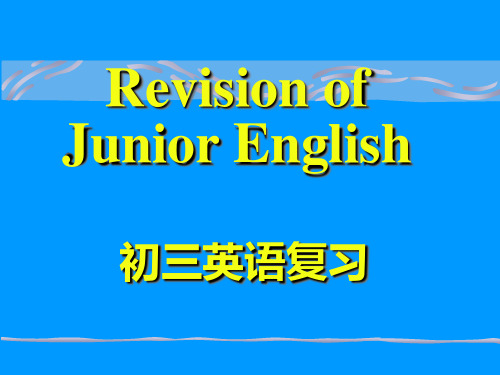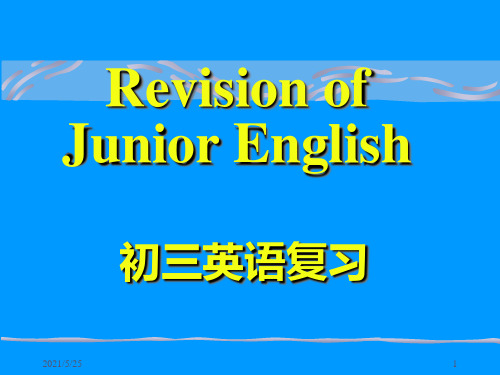初中英语语法ppt课件
合集下载
初中英语语法大全PPT课件

A. the first B. one of C. the second D. second
Pronouns
代词
代词的分类
人称代词 Personal Pronouns 物主代词 Possessive Pronouns 反身代词 Self Pronouns 不定代词 Indefinite Pronouns 指示代词 Demonstrative Pronouns 疑问代词 Interrogative Pronouns
* You, she and I all enjoy the music. 你我她都喜欢音乐。
4.she可以用来代表国家、船只、大
地、月亮等
* We love our motherland, we hope she’ll be stronger and bigger.
我们热爱我们的祖国,我们希望她更强大。
( C)5 The idea became ____ . He wanted to try
____.
A. strangly, it out B. strangly, out it
C. strange, it out D. strange, out it
( C)6 Beijing is ____ biggest cities in China.
4) 可用much, still, a little, even, far,three years等表示程度的状语来 修饰比较级
2. “the + 比较级,the + 比较级” 表示“ 越······就越······” *The more, the better.
越多越好。 THE+比较级。。。THE+比较级。。。
Revision of Junior English
Pronouns
代词
代词的分类
人称代词 Personal Pronouns 物主代词 Possessive Pronouns 反身代词 Self Pronouns 不定代词 Indefinite Pronouns 指示代词 Demonstrative Pronouns 疑问代词 Interrogative Pronouns
* You, she and I all enjoy the music. 你我她都喜欢音乐。
4.she可以用来代表国家、船只、大
地、月亮等
* We love our motherland, we hope she’ll be stronger and bigger.
我们热爱我们的祖国,我们希望她更强大。
( C)5 The idea became ____ . He wanted to try
____.
A. strangly, it out B. strangly, out it
C. strange, it out D. strange, out it
( C)6 Beijing is ____ biggest cities in China.
4) 可用much, still, a little, even, far,three years等表示程度的状语来 修饰比较级
2. “the + 比较级,the + 比较级” 表示“ 越······就越······” *The more, the better.
越多越好。 THE+比较级。。。THE+比较级。。。
Revision of Junior English
初中英语语法讲解PPT课件

双重所有格(of+’s的两种结合)
• P11-13 (textbook) • 做练习 • 作业 列出有关名词一讲疑惑不解或易错的5- 10个难点.
第二讲 冠词和数词
•
冠词是虚词,本身不能单独使用,也没有词义,它用在名词的前面,帮助指明名词 的含义。英语中的冠词有三种,一种是定冠词(the Definite Article),另一种是不定 冠词(the Indefinite Article),还有一种是零冠词(Zero Article)。 2.1不定冠词的用法 不定冠词a (an)与数词one 同源,是"一个"的意思。a用于辅音音素前,一般读作 [e],而an则用于元音音素前,一般读做[en]。 1) 表示"一个",意为one;指某人或某物,意为a certain。 A Mr. Ling is waiting for you.
2) 以o 结尾的名词,变复数时: a. 加s,如: photo---photos piano---pianos radio---radios zoo---zoos; b. 加es,如:potato--potatoes tomato--tomatoes c. 均可,如:zero---zeros / zeroes 3) 以f或fe 结尾的名词变复数时: a. 加s,如: belief---beliefs roof---roofs safe---safes gulf---gulfs; b. 去f,fe 加ves,如:half---halves knife---knives leaf---leaves wolf---wolves wife---wives life---lives thief---thieves; c. 均可,如: handkerchief: handkerchiefs / handkerchieves
初中英语语法课件ppt

vacation together.
过去将来时的使用:
一、过去将来时表示对于过去某一时间而言将要发生的动 作或存在的状态。 would或was /were going to + V
would可用于各种人称。
二、would +V还可表示过去的习惯动作,在这点上同used to同义。
When we were children, we would/used to go swimming every summer.
e) 用于条件从句“如果……想,设想”(接近if ……want to,或 if ……should) 例:Greater efforts to increase agricultural production must be made if food shortage ____________ avoided. A) is to be B) can be C) will be D) has been
一般现在时的动词形式: 动词原形 1.am;is ;are 2.have,has 3.第三人称单数形式-(e)s
肯定句:I watch television every day.
否定句:I don’t watch television every day.
疑问句:Do you watch television every day.
一般现在时的使用:
1.一般现在时表示总是、通常、习惯 性的动作或状态。
It snows in winter. I watch television every day.
2.用于对客观事实的普遍性的陈述。
Water consists of hydrogen and oxygen. Most animals kill only for food. The world is round.
过去将来时的使用:
一、过去将来时表示对于过去某一时间而言将要发生的动 作或存在的状态。 would或was /were going to + V
would可用于各种人称。
二、would +V还可表示过去的习惯动作,在这点上同used to同义。
When we were children, we would/used to go swimming every summer.
e) 用于条件从句“如果……想,设想”(接近if ……want to,或 if ……should) 例:Greater efforts to increase agricultural production must be made if food shortage ____________ avoided. A) is to be B) can be C) will be D) has been
一般现在时的动词形式: 动词原形 1.am;is ;are 2.have,has 3.第三人称单数形式-(e)s
肯定句:I watch television every day.
否定句:I don’t watch television every day.
疑问句:Do you watch television every day.
一般现在时的使用:
1.一般现在时表示总是、通常、习惯 性的动作或状态。
It snows in winter. I watch television every day.
2.用于对客观事实的普遍性的陈述。
Water consists of hydrogen and oxygen. Most animals kill only for food. The world is round.
初中英语语法ppt课件

04
Positions and connections
The usage of commonly used positions
At
used to indicate a specific point in time or place
In
used to indicate a period of time or a location within a larger space
Nouns that cannot be counted or have a plural form. Example: "I have some sugar in the cupboard."
The positive case of nouns
Passive nouns
Nouns that show session or ownership They are formed by adding's to the end of the noun Example: "The teacher's book"
Example
"The cat is bigger than the dog." - "bigger" is the comparative degree of the objective "big."
Formations
The comparative degree of advisors and advisors typically end with "- er" or "- ier", or can be formed by using the suffix "- er" or "- more"
初中英语语法大全精品PPT课件

多时,谓语用复数。 如:There is a sheep in the yard.(院子里有只绵羊)
There are some sheep in the yard.(院子里有一些绵羊) 4、maths, news等虽然有s结尾,但不是复数,因此谓语仍用单数: 如:The news is very exciting. (这个消息令人兴奋)
[注解]:
① ‘s还可以表示某人的家或者某个店铺, 如:my aunt’s(我阿姨家), the doctor’s(诊所)
② 两人共有某物时,可以采用 A and B’s 的形 如:Lucy and Lily’s bedroom(露西和丽丽合住的卧室)
Lucy’s and Lily’s bedroom(露西和丽丽分别的卧室)
如果表示整体概念,则谓语用单数形式, 如:Class Three is a very good class.(三班是好班) 如果表示其中的所有成员时,则谓语用复数形式, 如:Class Three have a map of China.(三班有张中国地图) 3、Chinese, Japanese, fish, sheep, people等表示单个时谓语用单数,表示许
如: box, child, orange;
不可数名词{u} 是不可以用简单的数词进行计数的名词。
如:water, news, oil, population, information .
英语可数名词的单复数
1、名词由单数变复数的基本方法如下: ①在单数名词词尾加s。 如:map → maps,boy→ boys,horse→ horses, table→ tables. ②s,o,x ,sh,ch结尾的词加es. 如:class→classes, box→boxes, hero→heroes, dish→dishes,
There are some sheep in the yard.(院子里有一些绵羊) 4、maths, news等虽然有s结尾,但不是复数,因此谓语仍用单数: 如:The news is very exciting. (这个消息令人兴奋)
[注解]:
① ‘s还可以表示某人的家或者某个店铺, 如:my aunt’s(我阿姨家), the doctor’s(诊所)
② 两人共有某物时,可以采用 A and B’s 的形 如:Lucy and Lily’s bedroom(露西和丽丽合住的卧室)
Lucy’s and Lily’s bedroom(露西和丽丽分别的卧室)
如果表示整体概念,则谓语用单数形式, 如:Class Three is a very good class.(三班是好班) 如果表示其中的所有成员时,则谓语用复数形式, 如:Class Three have a map of China.(三班有张中国地图) 3、Chinese, Japanese, fish, sheep, people等表示单个时谓语用单数,表示许
如: box, child, orange;
不可数名词{u} 是不可以用简单的数词进行计数的名词。
如:water, news, oil, population, information .
英语可数名词的单复数
1、名词由单数变复数的基本方法如下: ①在单数名词词尾加s。 如:map → maps,boy→ boys,horse→ horses, table→ tables. ②s,o,x ,sh,ch结尾的词加es. 如:class→classes, box→boxes, hero→heroes, dish→dishes,
初中英语语法PPT课件

初中英语语法总结
初中语法分类
• 初中语法项目分类:(共8类) • 一般分类 • 1、一般现在时 • 2、一般过去时 • 3、一般将来时 • 4、现在进行时 • 5、现在完成(进行)时 • 6、过去进行时 • 7、过去完成时 • 8、过去将来时
一般现在时
• 构成: • 动词用原形 • 三人称单数-s / es
D. were; have for • 2. Could you tell me what time the plane ______? • A. left B. leaves C. leaved D. was leaving • 3. One of us ______band last month. • A. leaves B. leave C. leaved D. left
• 构成: • 动词用过去时 • Be—was/ were
• 用法: • 表过去某个、段时间内动作及状态
• 象征词: • ago/just now /In1998 last/yesterday 等
一般过去时
• 规则变化: • 一般/去e 双写/辅+y结尾-ied • 不规则变化: • go-went come-came • do-did leave-left等
过去将来时
• 构成: • would + V 原形 • 多用宾语从句中
• 用法: • 过去看来将要发生的动作或状态
• 象征词: • He said that he… the next day .
过去将来时
• 例句: • He said that he would come here the next
• 3. Jim __________ (jump) on the bus as it ____ ______ (move) away.
初中语法分类
• 初中语法项目分类:(共8类) • 一般分类 • 1、一般现在时 • 2、一般过去时 • 3、一般将来时 • 4、现在进行时 • 5、现在完成(进行)时 • 6、过去进行时 • 7、过去完成时 • 8、过去将来时
一般现在时
• 构成: • 动词用原形 • 三人称单数-s / es
D. were; have for • 2. Could you tell me what time the plane ______? • A. left B. leaves C. leaved D. was leaving • 3. One of us ______band last month. • A. leaves B. leave C. leaved D. left
• 构成: • 动词用过去时 • Be—was/ were
• 用法: • 表过去某个、段时间内动作及状态
• 象征词: • ago/just now /In1998 last/yesterday 等
一般过去时
• 规则变化: • 一般/去e 双写/辅+y结尾-ied • 不规则变化: • go-went come-came • do-did leave-left等
过去将来时
• 构成: • would + V 原形 • 多用宾语从句中
• 用法: • 过去看来将要发生的动作或状态
• 象征词: • He said that he… the next day .
过去将来时
• 例句: • He said that he would come here the next
• 3. Jim __________ (jump) on the bus as it ____ ______ (move) away.
初中英语语法大全PPT优秀课件

7)掌握几种同义句转换
1. He is taller than any other student in his class.
= He is taller than the other students in his class.
= He is taller than any of the other students in his class.
* They haven’t come back yet.
★ such 修饰名词 so 修饰形容词、副词
*I have never seen such an
interesting film.
*This box is so heavy that I can’t
carry it.
2021/5/25
3
★ alone(单独、独自)作表语=by oneself lonely(孤独的)可作表语、定语
2021/5/25
28
用词的适当形式填空
1 He works very __h_a_r_d_____. He _h__a_r_d_l_y___
has a rest on Sunday. (hard)
2 __L_u_c_k__il_y__, he didn’t fail in the exam.(luck)
A. the latest B. later
C. early
D. as late
(B )2 The more we looked at the picture, ____.
A. we like it less B. the less we liked it
C. better we liked it D. it looked better
《初中英语语法》PPT课件

We wonder when he _______(start) started learning English.
•如:He said(that)there ______(be) no classes yesterday. were He told me he _______(can) swim. could The teacher asked him what he ____________(do) at seven. was doing My friend asked me when I ____________ would leave (leave) for Beijing. 或 was leaving had been He told me that he _______________(be) to Shanghai.
2:用that, if/whether, how,where,what,….等连接词填 空.
that they will visit our school next week. 1.I hear_____
who the girl is? 2.Do you know_____ how can get to the park? 3.Could you tell me _____I 4.We thought ______you had never been there before . that 5.Please tell me_______ you live. where 6.Mother asked me ___________ I had finished my if/whether homework.
If/whether(是否)的区别
• 一般情况下,if 和whether可以互换,但以 下4种情况只能用whether: • ①在不定式前:Whether to go there or not hasn’t been decided. • ②在介词前:It depends on(依靠) whether it is going to rain. • ③与or not连用:They are talking about whether to go there or not. • ④做主语从句:Whether he is right 主语 isn’t important. •
•如:He said(that)there ______(be) no classes yesterday. were He told me he _______(can) swim. could The teacher asked him what he ____________(do) at seven. was doing My friend asked me when I ____________ would leave (leave) for Beijing. 或 was leaving had been He told me that he _______________(be) to Shanghai.
2:用that, if/whether, how,where,what,….等连接词填 空.
that they will visit our school next week. 1.I hear_____
who the girl is? 2.Do you know_____ how can get to the park? 3.Could you tell me _____I 4.We thought ______you had never been there before . that 5.Please tell me_______ you live. where 6.Mother asked me ___________ I had finished my if/whether homework.
If/whether(是否)的区别
• 一般情况下,if 和whether可以互换,但以 下4种情况只能用whether: • ①在不定式前:Whether to go there or not hasn’t been decided. • ②在介词前:It depends on(依靠) whether it is going to rain. • ③与or not连用:They are talking about whether to go there or not. • ④做主语从句:Whether he is right 主语 isn’t important. •
- 1、下载文档前请自行甄别文档内容的完整性,平台不提供额外的编辑、内容补充、找答案等附加服务。
- 2、"仅部分预览"的文档,不可在线预览部分如存在完整性等问题,可反馈申请退款(可完整预览的文档不适用该条件!)。
- 3、如文档侵犯您的权益,请联系客服反馈,我们会尽快为您处理(人工客服工作时间:9:00-18:30)。
6
在被动语态中,主语是动作的承受者,主要用于下列几种情况 中: (1)不知道动作的执行者是谁。 This watch is made in China.这块手表是在中国制造的。 (2)没有必要指出动作的执行者是谁。 More trees must be planted every year.每年都应该种更多的 树。 (3)需要强调或突出动作的承受者。
2 一般过去时
did
was/were+过去分词
3 一般将来时 will/be going to+动词原 will/be going to+be+过去分词
形
4 过去将来时 would+动词原形
would+be+过去分词
5 现在进行时 am/is/are+现在分词
am/is/are+being+过去分词
B. will finish
C. will be finished D. would finish
过去将来时态:would + be+过去分词
6、The old scientist said that he ______ to visit their country
before long .
A. invited
1、The Chinese food _____ to be the healthiest in the world. A. considers B. is considering C. is considered D. has considered
过去时态:was/were +过去分词
2、John __,for he went swimming yesterday without permission.
A. would punished B. had punished
C. punished
D. was punished
现在进行时态:am/is/are +being +过去分词
3、---- Have you moved into the new house ?
---- Not yet .Rooms _______.
6 过去进行时 was/were+现在分词
was/were+being+过去分词
7 现在完成时 8 过去完成时 9 含情态动词
have/has+过去分词 had+过去分词
情态动词+动词原形
have/has+been+过去分词 had+been+过去分词
情态动词+be+过去分词 3
一般时态:am/is/are +过去分词
English is spoken by many people. ②He washed his shoes yesterday.
______on .
A. operated
B. was operated
C. was operating D. was being operated
一般将来时态:will + be+过去分词
5、The new school ______ when the new term begins.
A. finishes
A. are painting
B. are painted
C. are being painting D. are being painted
4
过去进行时态:was/were + being +过去分词
4、Mr. Wu was in hospital . when we went to see him , he
B. had invited
C. was inviting D. would be invited
5
现在完成时态:have/has + been +过去分词
7、With the help of the Hope Project, more and more new schools _____ in the poor area.
A. built
B. have built
C. have been built D. have been building
过去完成时态:had + been +过去分词
8、He came out and told us that the work __________.
A. finished
B. was finished
2.
被动语态基本构成:be+过去分词
被动语态由“助动词be+及物动词的过去分词”构成。 助动词有人称、数和时态的变化,其变化规则与be作为 连系动词时完全一样。其后的实义动词必须为及物动词, 或“动词+介词”构成的及物动词短语。
2
时态
主动语态
被动语态
1 一般现在时
do/does
am/is/are+过去分词
Chinese is spoken by more and more people in the world. 世界上越来越多的人说汉语。(强调汉语的使用广泛) (4)句子的主语是动作的承受者。 Many houses were washed away in the flood.许多房屋被洪 水冲走了
1
动词的语态
1.英语中动词有两种语态: 主动语态表示主语是谓语动词的执行者。 被动语态表示主语是谓语动作的承受者。例如:A talk on science will be given in our school next Monday. 下周一在我们学校将会有一场关于科学的演讲。
7
(1)主动语态变为被动语态:
把主动语态改为被动语态可按“一变 、二套 、三注意 ” 来进行。即:
①变---把主动语态的宾语改为被动语态的主语,把主 动语态的主语改为被动语态的介词by的宾语。
②套---根据原句的时态套用相应时态。 ③注意--注意人称的变化而引起的主谓一致问题。 例:①Many people speak English.
C. had finished D. had been finished
情态动词:情态动词+be +过去分词
9、The programmes ___ easily if you use a short wave radio.
A. can pick up B. pick up
C. picked up D. can be picked up
在被动语态中,主语是动作的承受者,主要用于下列几种情况 中: (1)不知道动作的执行者是谁。 This watch is made in China.这块手表是在中国制造的。 (2)没有必要指出动作的执行者是谁。 More trees must be planted every year.每年都应该种更多的 树。 (3)需要强调或突出动作的承受者。
2 一般过去时
did
was/were+过去分词
3 一般将来时 will/be going to+动词原 will/be going to+be+过去分词
形
4 过去将来时 would+动词原形
would+be+过去分词
5 现在进行时 am/is/are+现在分词
am/is/are+being+过去分词
B. will finish
C. will be finished D. would finish
过去将来时态:would + be+过去分词
6、The old scientist said that he ______ to visit their country
before long .
A. invited
1、The Chinese food _____ to be the healthiest in the world. A. considers B. is considering C. is considered D. has considered
过去时态:was/were +过去分词
2、John __,for he went swimming yesterday without permission.
A. would punished B. had punished
C. punished
D. was punished
现在进行时态:am/is/are +being +过去分词
3、---- Have you moved into the new house ?
---- Not yet .Rooms _______.
6 过去进行时 was/were+现在分词
was/were+being+过去分词
7 现在完成时 8 过去完成时 9 含情态动词
have/has+过去分词 had+过去分词
情态动词+动词原形
have/has+been+过去分词 had+been+过去分词
情态动词+be+过去分词 3
一般时态:am/is/are +过去分词
English is spoken by many people. ②He washed his shoes yesterday.
______on .
A. operated
B. was operated
C. was operating D. was being operated
一般将来时态:will + be+过去分词
5、The new school ______ when the new term begins.
A. finishes
A. are painting
B. are painted
C. are being painting D. are being painted
4
过去进行时态:was/were + being +过去分词
4、Mr. Wu was in hospital . when we went to see him , he
B. had invited
C. was inviting D. would be invited
5
现在完成时态:have/has + been +过去分词
7、With the help of the Hope Project, more and more new schools _____ in the poor area.
A. built
B. have built
C. have been built D. have been building
过去完成时态:had + been +过去分词
8、He came out and told us that the work __________.
A. finished
B. was finished
2.
被动语态基本构成:be+过去分词
被动语态由“助动词be+及物动词的过去分词”构成。 助动词有人称、数和时态的变化,其变化规则与be作为 连系动词时完全一样。其后的实义动词必须为及物动词, 或“动词+介词”构成的及物动词短语。
2
时态
主动语态
被动语态
1 一般现在时
do/does
am/is/are+过去分词
Chinese is spoken by more and more people in the world. 世界上越来越多的人说汉语。(强调汉语的使用广泛) (4)句子的主语是动作的承受者。 Many houses were washed away in the flood.许多房屋被洪 水冲走了
1
动词的语态
1.英语中动词有两种语态: 主动语态表示主语是谓语动词的执行者。 被动语态表示主语是谓语动作的承受者。例如:A talk on science will be given in our school next Monday. 下周一在我们学校将会有一场关于科学的演讲。
7
(1)主动语态变为被动语态:
把主动语态改为被动语态可按“一变 、二套 、三注意 ” 来进行。即:
①变---把主动语态的宾语改为被动语态的主语,把主 动语态的主语改为被动语态的介词by的宾语。
②套---根据原句的时态套用相应时态。 ③注意--注意人称的变化而引起的主谓一致问题。 例:①Many people speak English.
C. had finished D. had been finished
情态动词:情态动词+be +过去分词
9、The programmes ___ easily if you use a short wave radio.
A. can pick up B. pick up
C. picked up D. can be picked up
